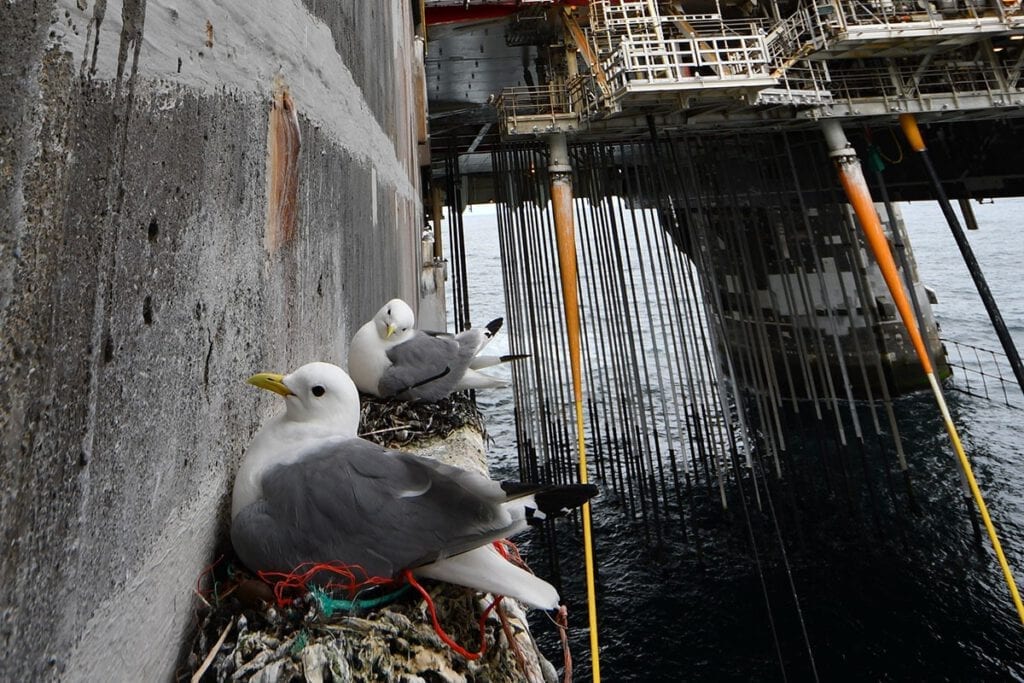Kittiwakes find refuge on offshore oil rigs
Offshore oil rigs serve as a breeding refuge for Norwegian black-legged kittiwakes. Although they are few in number, these birds produce more chicks than kittiwakes in natural colonies along the coast, to the benefit of the impoverished Norwegian kittiwake population.
Several causes of population decline.
The black-legged kittiwake Rissa tridactyla, a small gull feeding on the surface of the ocean, is the most numerous gull in Norway. However, the population has declined rapidly in many parts of the North Atlantic over recent decades. The species is listed as vulnerable in the global red list and endangered in the Norwegian red list, emphasizing the need for careful management of its populations. The decline in Norway is complex and not fully understood, but food shortages both during winter and in the breeding season is likely an important factor, enforced by increased predation from white-tailed eagles, corvids and large gulls as the breeding density decreases and colonies gets fewer.
However, faced with a changing environment, the kittiwake has an ace up its sleeve. It has proven to be unusually flexible in its choice of nesting sites. Kittiwakes normally breed in colonies on narrow ledges on steep nearshore cliffs, but also appear to thrive on man-made structures such as buildings and bridges.
“The establishment of kittiwake colonies in these relatively novel breeding habitats is very interesting in light of the severe decline of many colonies on natural cliffs around the Atlantic Ocean”, says Signe Christensen-Dalsgaard, seabird researcher at the Norwegian Institute for Nature Research (NINA).
Citizen science gives researchers insight into restricted access areas.
Assisted by the crew on oil rigs and supply vessels, Christensen-Dalsgaard and her colleagues have studied the kittiwakes breeding on oil rigs.
“Oil rigs are generally not accessible for researchers, so we wanted to test if a type of citizen science could be applied to monitor the reproductive performance of kittiwakes on such locations”, says Christensen-Dalsgaard.
They compared information on breeding success from the oil rigs with that of kittiwakes breeding in nearby mainland colonies, both on natural cliffs and on man-made structures. Studying the breeding ecology of kittiwakes in these three notably different breeding habitats allowed the researchers to disentangle some of the drivers of the species’ productivity.
Is food availability or predators the most limiting factor?
The oil rigs included in the study are situated 60–170 kilometers off the mainland coast. The researchers therefore expected that kittiwakes breeding on oil rigs experience both different food availability and lower exposure to predators than those breeding at coastal colonies. On the other hand, colonies associated with human settlements on the coast likely experience comparable food availability as those on nearby natural cliffs but different levels of disturbance from humans and predators.
“We hypothesized that if predation pressure is the most important limiting factor for the number of chicks produced, the offshore kittiwake colonies would have the highest productivity, followed by those breeding on human structures. However, if food availability is the principal driver, the two types of coastal colonies would have similar productivity, with the offshore colonies differing from these.”
The study showed that kittiwakes breeding on oil rigs had a good level of chick productivity, higher than that of kittiwakes breeding on man-made structures on the coast, and much higher than that of kittiwakes breeding in natural habitats in the study area. These findings correspond well with the predictions of the first hypothesis, indicating that predation pressure might be a key driver of kittiwake productivity in the study area.
“However, we cannot exclude the possibility that food availability played a role as we lack detailed information on where the birds were foraging. It could be that birds breeding offshore also profit from a shorter distance to the best foraging areas at sea.”
Nature is rarely black and white.
Although oil rigs are usually considered a risk to marine life due to for instance the risk of oil spillage and mortality due to birds colliding with the structures, oil rigs might also have positive effects acting as artificial reefs and providing a refuge for marine fauna. As for the kittiwakes, breeding on offshore oil rigs has apparently more positive than negative impacts.
“Representing only a tiny percentage of the total kittiwake population, these rig breeders are not likely to salvage the population as a whole. Nonetheless it is a valuable contribution of juveniles to the impoverished kittiwake population in Norwegian waters.”
Keeping a good dialogue with the companies and the rig personnel on best practice for managing kittiwakes breeding offshore, will ensure both the health of the kittiwakes and the people operating these rigs in the future.
Dialogue is the key also in urban areas, where kittiwakes can be a source of conflict, as the birds are perceived as noisy and messy. However, these urban colonies might prove imperative for the survival of the species in Norway.
«Although it might not always be perceived as such by people encountering it in the urban environment, the kittiwake is a threatened species, just like other charismatic inhabitants of the northern environment, such as the Atlantic puffin and the Arctic fox. This is something that should be acknowledged, and urban authorities and management agencies should work to facilitate co-existence between urban kittiwakes and people. Hopefully people will learn to appreciate this amazing little gull.»
Read the article:
This article was also published by Sciencenorway.no and the Norwegian Institute for Nature Research (NINA)
Contact person: Signe Christensen-Dalsgaard, NINA

Photo: Signe Christensen-Dalsgaard, NINA

Photo: Supply Vessels

Map: NINA